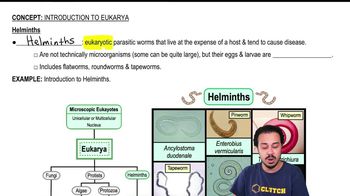Briefly discuss the importance of lichens in nature. Briefly discuss the importance of algae in nature.
 Tortora 14th Edition
Tortora 14th Edition Ch. 14+15 - Principles of Disease and Epidemiology | Microbial Mechanisms of Pathogenicity
Ch. 14+15 - Principles of Disease and Epidemiology | Microbial Mechanisms of Pathogenicity Problem 12.8a
Problem 12.8aBy what means are helminthic parasites transmitted to humans?
 Verified step by step guidance
Verified step by step guidance
Verified Solution
Key Concepts
Helminthic Parasites

Transmission Routes

Preventive Measures

Why is it significant that Trichomonas does not have a cyst stage? Name a protozoan parasite that does have a cyst stage.
The definitive host for Plasmodium vivax is
a. human.
b. Anopheles.
c. a sporocyte.
d. a gametocyte.
Differentiate the terms in each of the following pairs:
a. etiology and pathogenesis
b. infection and disease
c. communicable disease and noncommunicable disease
Using the following data, draw a graph showing the incidence of influenza during a typical year. Indicate the endemic and epidemic levels. <IMAGE>
The emergence of new infectious diseases is probably due to all of the following except
a. the need of bacteria to cause disease.
b. the ability of humans to travel by air.
c. changing environments (e.g., flood, drought, pollution).
d. a pathogen crossing the species barrier.
e. the increasing human population.